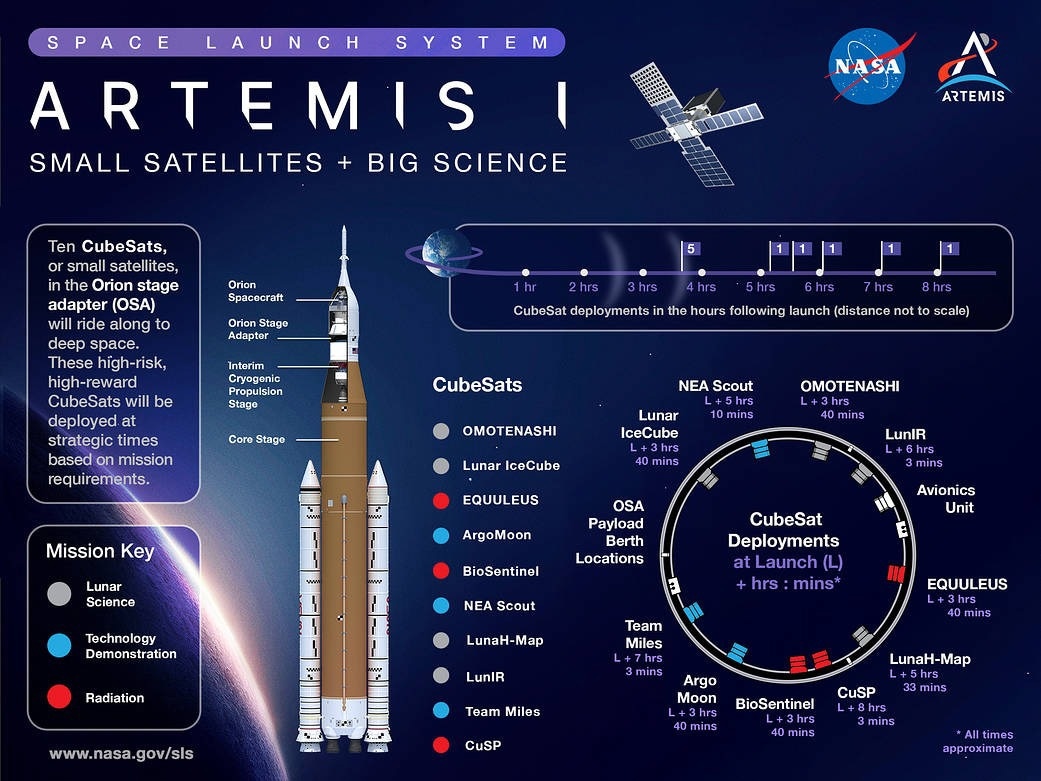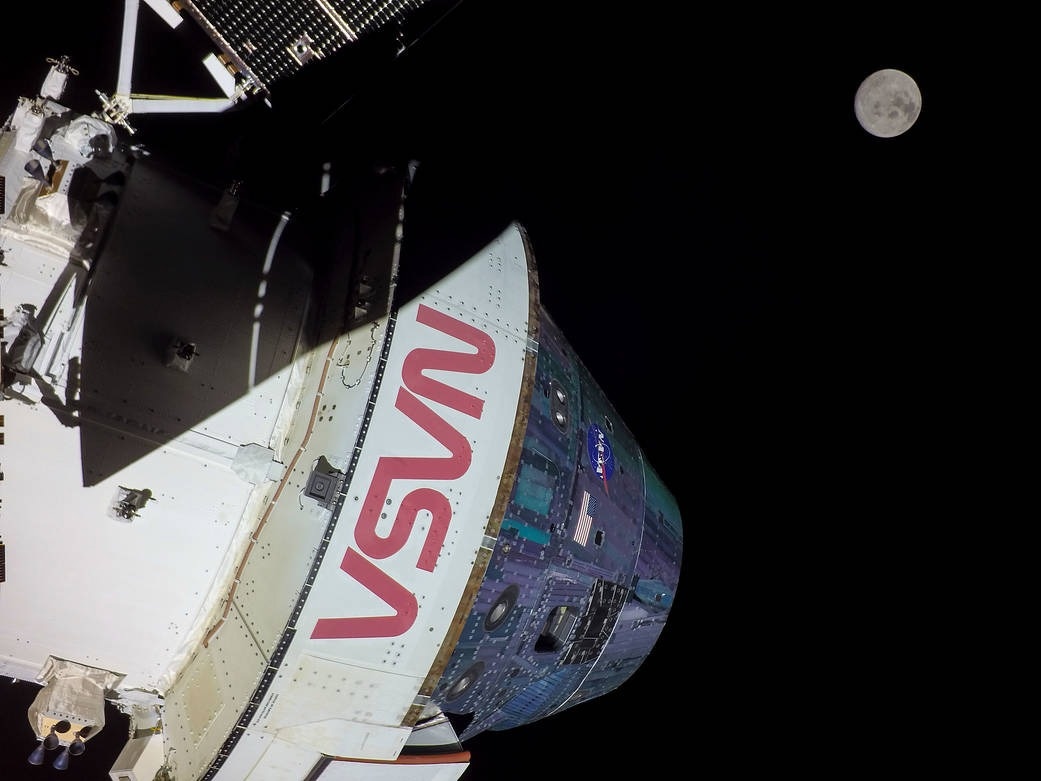On Wednesday, November 16, 2022, the historic Artemis I mission blasted off from Florida’s famous Kennedy Space Center.
Part of a long-term mission to carry humanity back to the surface of the moon, the Artemis I mission is comprised of the Orion spacecraft designed to carry up to eight people to the moon, and the Space Launch System (SLS)— the most powerful rocket ever designed and built by humanity.
One of the key objectives of this pilot uncrewed mission is to test the rigors of space travel experienced by this system and to ensure the crewed Artemis II mission and the subsequent trips are as safe as possible.
Such an ambitious mission requires a range of innovative and pioneering sensors. But this is not the extent of sensors launched into space by the SLS as part of the Artemis mission.
The rocket is also carrying a secondary payload, a barrage of tiny satellites — or CubeSats — each tasked with its objectives and the sensors needed to conduct these tasks.
Here, an alphabetic rundown of the sensors carried by Artemis I in its primary and secondary payloads is presented.
A
Designed by the Italian Space Agency (ASI) ArgoMoon will be one of the first CubeSats from Europe to journey outside Earth’s orbit.
As it does so, ArgoMoon will take images of Orion’s launch stage as the craft is jettisoned towards the moon, and as the craft jettison the other CubeSats listed here.
B
Broadband InfraRed Compact High-Resolution Exploration Spectrometer (BIRCHES) is an instrument carried by the Lunar IceCube 6U CubeSats developed by Morehead State University in partnership with NASA’s Goddard Space Flight Center.
BIRCHES is capable of measuring the distribution of this water across the moon as well as detecting water in the moon’s thin atmosphere, the exosphere. This will help the Lunar IceCube 6U ‘sniff out’ water and other resources on the moon that could be utilized in future crewed space missions, as the tiny 31 lbs CubeSat orbits the moon once every seven hours.

Image Credit: NASA/Kevin O’Brien
C
The CubeSat to study Solar Particles (CuSP) is a CubeSat designed to orbit the sun studying radiation from the star as well as solar weather such as solar winds and other phenomena that can affect infrastructure here on Earth such as radio systems or power grids.
This could help engineers and scientists predict space weather before it can hit Earth’s magnetosphere and trigger potentially damaging geomagnetic storms.
The four Coarse Sun Sensor (CSS) arrays designed by Redwing and attached to the Orion’s European Service Module (ESM) will perform sun acquisition and solar array pointing functions for the Orion spacecraft, ensuring the craft’s primary power, thermal control, and propulsion component remain powered up with solar energy.
D
The European Space Agency (ESA) has equipped the Orion spacecraft with a set of five dosimeters to measure radiation in both the deep space and lunar environments as thoroughly as possible.
Each ESA Active Dosimeter—Mobile Units (EAD-MUs) is around the size of a deck of cards and has been mounted on Orion in different locations. Similar to devices deployed on the International Space Station (ISS), the dosimeters will allow scientists to see how radiation fluctuates during Orion’s journey.
Additionally, EAD-MUs will measure the total levels of ionizing energies the Orion travel through as it journies almost half a million kilometers from Earth.
E
The mission of the EQUilibriUm Lunar-Earth point 6U Spacecraft (EQUULEUS) Cubesat created by the Japanese Aeroscape Exploration Agency (JAXA) is to measure radiation in space immediately surrounding the Earth.
It will do this by studying the inner region of Earth’s magnetic field — the plasmasphere — which is composed of gas that has been stripped of electrons to create plasma.
This will help scientists plan future space missions to protect delicate electronics and astronauts from space radiation.
H
Helga is one of three mannequins that will be riding the Orion spacecraft around the moon. The female-bodied mannequin is equipped with thousands of sensors to measure the doses of radiation that future Artemis mission astronauts will be exposed to.
The 100 or so dosimeters glued onto the outside of Helga will help researchers determine down to the organ level the level of cosmic radiation astronauts experience. This is especially helpful in determining the dosage experienced by sensitive organs like the stomach, lungs, or uterus.
L
The LunaH-Map CubeSat’s mission is designed to last just 60 days as its neutron detector uses a material called Cs2YLiCl6:Ce (CLYC) to detect neutrons usually locked up in atoms.
The purpose of this is to find neutrons that have interacted with hydrogen and thus to create a map of hydrogen around the moon’s surface as well as the amount of this light element that is locked up in water ice located deep with dark shadowy lunar craters.
During its two-month mission, LunaH-Map will also attempt to determine how much hydrogen is located around a meter below the lunar surface.
Artemis I: We Are Ready
Video Credit: NASA
M
Miniaturized Electron and Proton Telescope (MERiT) is part of the CuSP craft’s mission to study space weather which counts high-energy solar particles.
Moonikin Campos (commander) is a NASA mannequin aboard the Orion space vehicle that is designed to measure the pressures and loads that astronauts experience at launch.
Named after the electrical engineer who was instrumental to saving the Apollo 13 crew, Arturo Campos, Moonikin will be decked out in the new Orion Crew Survival System flight suit — the same suit that Artemis astronauts will wear during the mission from launch, entry, and other dynamic phases.
The male-bodied mannequin Moonikin is also equipped with two radiation sensors. Sensors also surround Moonikin under its headrest and behind its seat, which will record acceleration and vibration data throughout the mission.
Data from the Moonikin’ and his artificial colleagues will help NASA protect its astronauts during the Artemis II mission, the first in more than 50 years that will send crew around the Moon.
N
The NEACam is part of the Near-Earth asteroid Scout (NEAscout) deployed from the Orion craft to begin a two-year journey a target asteroid carried by a light sail that uses the momentum from light emerging from the sun as propulsion.
When it gets around 25,000 to 31,000 miles (approximately 40,000–50,000 km) from its target NEACam — a 20-megapixel CMOS image sensor with an array size of 3840 x 3840 pixels — will identify the asteroid. Then at a distance of between 62 and 75 miles, NEACam will capture images of the asteroid and send these back to Earth.
This will help NASA scientists better understand the composition of asteroids and this asteroid’s position in space, shape, and rotation. The images will also grant data regarding the dust surrounding asteroids, something vital for teams that aim to land a craft on the surface of these space rocks.

Image Credit: NASA
O
Created by the JAXA, the Outstanding Moon exploration Technologies demonstrated by Nano Semi-Hard Impactor (OMOTENASHI) is a CubeSat designed to measure lunar surface radiation and investigate soil mechanics using accelerometers.
Accelerometer devices measure vibration or acceleration by ‘squeezing’ a piezoelectric material and creating an electrical charge that is proportional to the change in mass caused by the pressure experienced.
To do this OMOTENASHI will eject a 2.2 lb (1 kg) nanolander powered by a disposable rocket which allows it to descend to the lunar surface.
The Orion Camera System provided by Redwing as part of a contract with Lockheed Martin is made up of 11 cameras both inside and outside the Orion module.
The role of these cameras will be to facilitate in-flight inspection of the spacecraft from its docking hatch to the main engine. It will also provide data to the Camera Controller for machine vision processing to determine Orion’s position and velocity relative to Earth.
S
Skyfire is a Cubesat designed by Lockheed Martin, now renamed ‘LunIR.’ However, this tiny satellite's mission remains unchanged to capture images of the lunar surface.
These images will help to characterize the lunar surface’s composition and structure and how it interacts with space. This data could help plan future missions to the moon and enable scientists to better select landing sites across the lunar surface.
The LunIR images could also help locate potentially hazardous obstacles on the moon that could endanger astronauts during future crewed Artemis missions.
V
Part of the CuSP CubeSat the Vector Helium Magnetometer (VHM) monitors the strength and direction of magnetic fields and is designed to monitor the strength and direction of the sun’s magnetic fields.
Z
Zohar is the mannequin sister of Helga, who joins her sibling and Moonikin, as the faux crew of the Orion spacecraft on Artemis I. In addition to possessing the 100 dosimeters also worn by her sister, Zohar will be equipped with 100 additional detectors on a space vest designed to provide protection against cosmic radiation.
The fact Helga is not afforded this vest will help researchers determine just how effective it is in shielding Zohar from cosmic radiation.
References and Further Reading
Lea. R, Artemis 1 CubeSats: The 10 tiny satellites hitching a NASA ride to the moon, Space, (2022), https://www.space.com/nasa-artemis-1-moon-mission-cubesats#section-lunar-icecube
Artemis, NASA, https://www.nasa.gov/specials/artemis/
Public Names ‘Moonikin’ Flying Around Moon on NASA’s Artemis I Mission, NASA, (2021), https://www.nasa.gov/press-release/public-names-moonikin-flying-around-moon-on-nasa-s-artemis-i-mission
HELGA AND ZOHAR TRAVEL TO THE MOON: AN INTERNATIONAL COLLABORATION ABOARD ARTEMIS I, International Astronautical Federation, [online] https://www.iafastro.org/events/iac/iac-2022/iaf-global-networking-forum/tuesday-20-september/helga-and-zohar-travel-to-the-moon-an-international-collaboration-aboard-artemis-i.html
Disclaimer: The views expressed here are those of the author expressed in their private capacity and do not necessarily represent the views of AZoM.com Limited T/A AZoNetwork the owner and operator of this website. This disclaimer forms part of the Terms and conditions of use of this website.